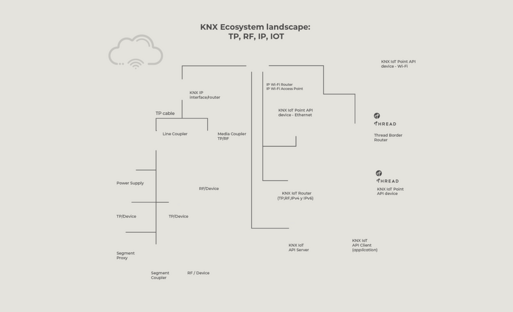
I dispositivi e le soluzioni KNX IoT fanno evolvere le case e gli edifici intelligenti di al livello successivo.
Perché KNX IoT?
- Interoperabilità e sicurezza: KNX è stato il punto di riferimento quando si parla di interoperabilità. Basta prendere due dispositivi certificati di qualsiasi fornitore e questi lavoreranno insieme a livello di applicazione in modo sicuro. Seguendo questa filosofia, KNX IoT è stato progettato per mantenere il più alto livello di sicurezza. I dispositivi KNX IoT sono dotati di sicurezza incorporata per progettazione. Con questa nuova e robusta tecnologia KNX IoT, produttori e sviluppatori possono costruire i migliori dispositivi, soluzioni e servizi che saranno installati dai professionisti del settore delle case e degli edifici intelligenti.
- Dispositivi IoT KNX nativi (IPv6): I dispositivi KNX utilizzano ora un nuovo approccio per adattarsi all'architettura IPv6. La nuova generazione di dispositivi KNX IoT sarà in grado di connettersi alle reti IP (via cavo e/o wireless) per comunicare con altri dispositivi KNX IoT e con i dispositivi KNX classici che utilizzano Twister Pair o Radio Frequenza.
- API standardizzata: Per i dispositivi che devono essere integrati in una rete KNX, è ora possibile grazie a un'API standardizzata in grado di connettersi alle installazioni KNX. Questa API è semplice, sicura, astrae dalle conoscenze specifiche di KNX ed è a prova di futuro.
- Uno strumento: ETS: Tutte queste funzionalità sono rese possibili dall'uso di ETS. Con ETS, i dispositivi KNX di oltre 500 produttori possono essere configurati indipendentemente dal loro livello fisico e le informazioni del progetto possono essere esportate a qualsiasi KNX IoT API Server utilizzando uno strumento indipendente dal fornitore. ETS fornisce l'interoperabilità di base in uno strumento attraente con un'interfaccia utente moderna.
- KNX, il più grande ecosistema di automazione domestica e degli edifici: La nuova possibilità di comunicare utilizzando la tecnologia KNX offre una maggiore flessibilità. I produttori possono ora utilizzare le nuove possibilità di sviluppo per creare prodotti e soluzioni innovative, così come i professionisti hanno maggiori possibilità di creare un ecosistema KNX più ampio nei loro progetti.
Rendere intelligente qualsiasi casa ed edificio con KNX IoT
Scoprite perché KNX IoT apre un mondo di possibilità per case ed edifici intelligenti in questo breve video introduttivo.
Potete trovare video e webinar più dettagliati su KNX IoT sul nostro canale YouTube.
KNX, il più grande panorama di sviluppo del suo genere
Nel 2023 è stata presentata al mondo un'innovativa piattaforma di sviluppo che funge da base per soluzioni straordinarie , consentendo di risolvere tutti i casi aziendali nei settori verticali della casa intelligente e dell'edilizia. Dai singoli prodotti ai servizi, qualsiasi produttore o sviluppatore può trovare le risorse necessarie per creare soluzioni uniche.
Scoprite come funziona l'Ecosistema KNX passando il mouse sui diversi elementi nell'immagine sottostante.
Sviluppo KNX IoT e Incubatore KNX Startup
Interessato allo sviluppo KNX IoT? Scoprite di più su KNX IoT e su come sviluppare per KNX IoT, i benefici e il supporto che KNX offre attraverso il nostro KNX Startup Incubator.
Unisciti a noi nel nostro viaggio
Create un account MyKNX per rimanere aggiornati sulle ultime novità di KNX IoT, sugli eventi tecnologici, sui prodotti KNX innovativi e molto altro. Entrate a far parte della nostra comunità per accedere ad approfondimenti esclusivi ed essere parte del futuro dell'energia sostenibile. Iscriviti oggi stesso e rimani connesso!




















